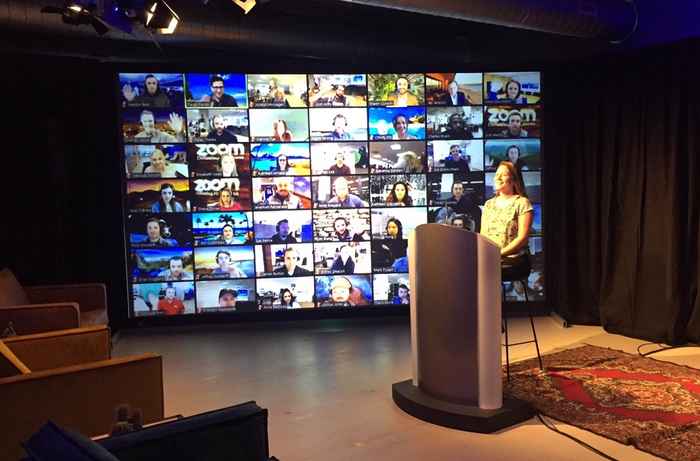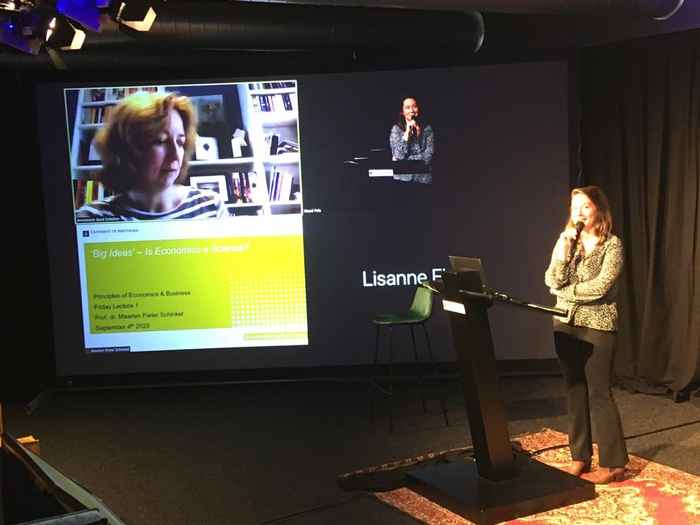COVID-19 sparks creativity among UvA Economics and Business lecturers
2 September 2020

Unfortunately, the faculty has to comply with the limited options available on campus due to the now familiar public health (RIVM) regulations. And that comes at a time with the highest ever projected student numbers for 2020-2021 with more than 1,500 students enrolled in some courses. This was a challenge for the teaching board and the lecturers. Mark van der Veen, Director of Education of the Business master’s programmes asked himself ‘How can we provide the best possible education that students will enjoy?’ He sees how lecturers have shown an enormous drive, creativity and energy working together to innovate and experiment.
More online interaction
Before the summer, education consultants Janine Smit, Maud Pols, and the three directors of education worked day and night to develop a vision for online education. Peter van Baalen, Director of Education responsible for the bachelor’s programmes at UvA Economics and Business, saw challenges in the online education vision: ‘How can we make lectures for such large numbers of students attractive and still do this efficiently?’ Spending hours on Zoom with 1,500 students didn’t seem to be a good idea, so the large-scale lectures have been replaced with brief, inspirational videos called ‘knowledge clips’. A revolutionary idea at UvA Economics and Business. Students watch the knowledge clips prior to taking part in an interactive Q&A session with the lecturer. Van Baalen also saw a solution to a second challenge in these knowledge clips: Motivating students to actively participate and be enthusiastic about their classes. ‘This ‘flipping the classroom’ approach means that students are well-prepared by watching the videos and reviewing the course material at home. The students then discuss the course material with the lecturer without having to introduce the material a second time. This expands the interaction between students and lecturers and between the students themselves, even in remote education. From what we’ve seen, our students appreciate this method.’
Creating a community
Van Baalen says that there is also a third challenge to be addressed: ‘Studying isn’t just about a transfer of knowledge. Being part of an academic community and social aspects are also important. How do we create a sense of community among our first-year students?’ There are 50 senior students working for the university in its mentoring system. They have been asked to organise fun activities within the limitations of the COVID-19 restrictions and stay in contact with small groups of first-year students. New students can always turn to these mentors with any questions they might have and the mentors will help them either online, or when possible, on the campus.

Creativity and innovation using hybrid education
Fortunately the campus offers some scope for meeting in groups, with around 20 percent of the normal capacity available. Mark van der Veen: ‘We’re using this option in lectures suitable for hybrid learning and this is aimed mainly at first-year students who are studying at the university for the first time'. In this learning method, the lecturer is physically present on campus along with a small number of students. There are two formats used in hybrid learning: synchronous and asynchronous. In the synchronous approach, students at home watch a lecture ‘live’ and are able to participate in the discussion. In the asynchronous approach, the lecture is recorded and students can watch the lecture at home on their own time, without the possibility of interaction.
Hybrid Learning Theatre
Using the synchronous format, Microeconomics professor Maarten Pieter Schinkel, together with Dr Pushpika Vishwanathan, came up with a creative solution for the larger courses with more than 1,500 students, such as Principles of Economics and Business. They arranged for the lecture to be held in a grand theatre-like studio setting, with a small number of students attending. Maud Pols, the project manager who was closely involved in setting up this Hybrid Learning Theatre says ‘We had 10 to 15 students present in the theatre who kept a distance of 1.5 metres from each other. They were able to discuss and debate the course material with their fellow students and the lecturer during the lecture. We used two cameras to switch the point of view, making the lecture dynamic and inspirational for students watching at home. Students have the choice of joining in live or getting involved in the discussion and asking questions using the chat feed.’
Home studio
Hans Borman, professor of Digital Business, set up his own studio at home. ‘Education and technology has been a hobby of mine for more than 30 years. My challenge was to use relatively cheap equipment used in television to build a home studio. Now I can broadcast a ‘talk show’ sitting at my desk without anyone being physically present.’ In cooperation with a number of universities abroad, Borgman has also set up a virtual international exchange programme for students. ‘Students at the partner universities abroad are now able to study at the UvA for a semester’. In addition to online lectures, online social activities have also been planned for students. ‘Amsterdam’s nightlife is something they can catch up on later’, says Borgman, laughing.
Hotel venues
Amsterdam Business School dean Marc Salomon has come up with a concept for students who, for example, are combining a fulltime job with an MBA. According to Salomon, ‘Some students didn’t want to enrol if the only option was online lectures. That’s why every student can choose to attend lectures in a lecture hall or take part in interactive lectures online. To accommodate an MBA class of 40 students while complying with the National Institute for Public Health social distancing rules, you need a classroom about the same size as half a hockey pitch. Since we don’t have many large lecture halls on the Roeterseiland Campus, we looked for facilities at a number of large hotels in the vicinity that host conventions. This solution kills two birds with one stone. The hotels are happy to have extra income and we’re able to accommodate out students by offering the flexibility they need at a time when they’re working and studying.’
Ongoing evaluation and adjustments
Massimo Giuliodori, the Director of Education for Economics master’s programmes, has continuously emphasised the need for intensive and ongoing evaluation of new educational methods: ‘While a few of these innovative educational concepts have been tried elsewhere, such as at Australian universities, or closer to home in Leuven, it remains to be seen whether they actually lead to a better learning experience. In the coming time we will listen carefully to what students and lecturers have to say so we can quickly make adjustments if certain methods don’t work. We mustn’t make the mistake of making this all about the technology. In our education, the focus continues to be on the student and the lecturer. Last but not least, I’m convinced that education will never be the same after COVID-19. We’ll retain and continue perfecting many of the things that work effectively when we return to the classroom’, says Giuliodori in closing.